Nusa Kambangan
Nusa Kambangan (also Nusakambangan, Kambangan island, or Pulau Nusa Kambangan) island is located in the Indian Ocean, separated by a narrow strait from the south coast of Java; the closest port is Cilacap in Central Java province. Dubbed by one international journalist the "Alcatraz of Indonesia",[1] the island is notorious for its Supermax prisons, home to convicted murderers, terrorists, drug traffickers, and those convicted in high-profile corruption cases. It is sometimes known as Execution Island because the island is the main location for carrying out capital punishment around Java.[2]
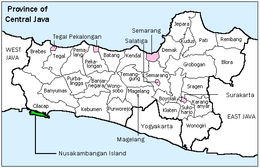 | |
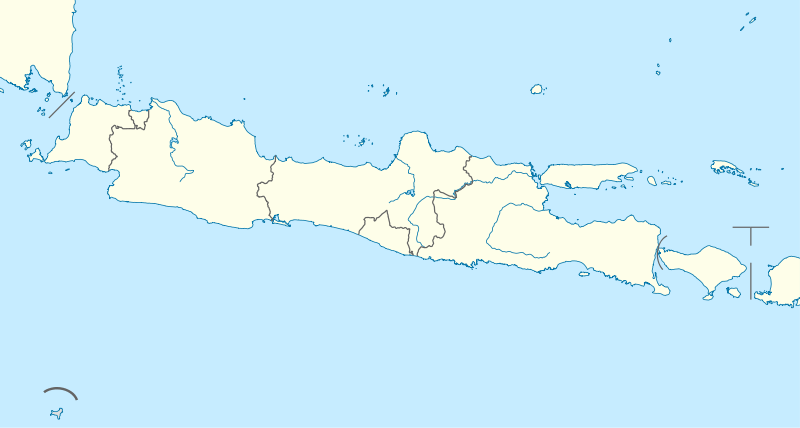 Nusa Kambangan 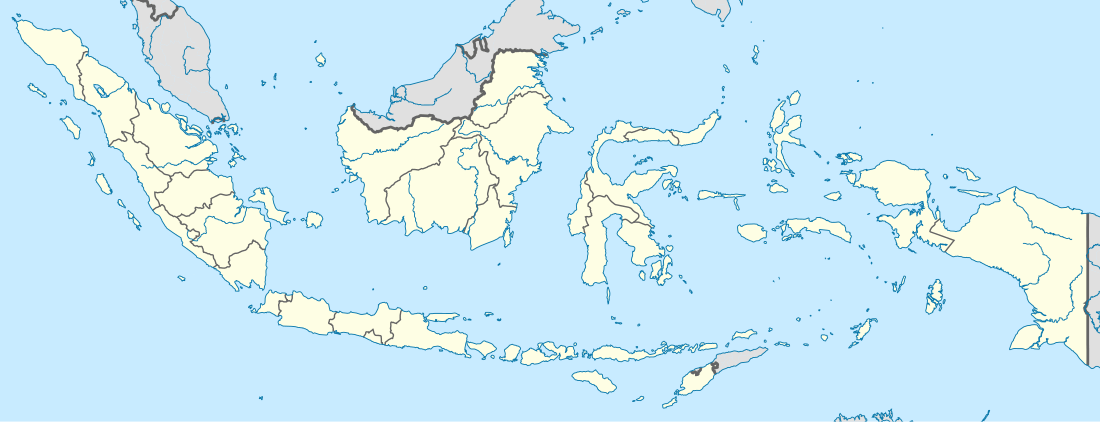 Nusa Kambangan | |
| Geography | |
|---|---|
| Location | South East Asia |
| Coordinates | 7°45′S 108°55′E |
| Area | 121 km2 (47 sq mi) |
| Administration | |
Indonesia | |
| Province | Central Java |
| Regency | Cilacap |
| Demographics | |
| Population | Around 3000 natives, and several hundred inmates |
| Ethnic groups | Javanese |
History

The island was made into a prison island during the era of Dutch rule. The colonial government built a high security prison on the isolated island to exile criminals and political dissidents. The prison on Nusa Kambangan was opened in the mid-1920s by Indonesia's Dutch colonial rulers and was once considered the harshest penal institution in Southeast Asia. The island was declared off-limits in 1905 by the Dutch.
Its use as a prison island continued after independence. During the rule of former President Suharto, hundreds of political dissidents were imprisoned on the island. Most were political prisoners, members of the banned Communist Party of Indonesia or sympathizers. These political prisoners were never brought to trial, and many of them died from hunger or illness.
In 1996, the island was opened to the public as a tourist destination.
The island has also been involved in refugee handling. About 140 Afghan refugees were detained on the island after their boat, which was en route to Christmas Island, Australia, sank in rough seas on August 17, 2001.[3] However, more than 90 of these refugees would later escape on September 19, 2001, sailing away in small fishing boats and are believed to have headed for Australia.[4]
The island was affected by the 2006 Pangandaran earthquake and tsunami, when a 7.7-magnitude undersea earthquake occurred off the coast of west Java. At least 11 villagers disappeared and 8 people were killed in the ensuing tsunami, two of which were prisoners at one of the Permisan prisons.[5] At least fifteen inmates on Nusa Kambangan were also missing.[6]
Geography, flora and fauna
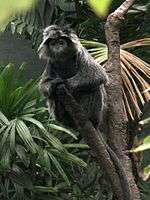
Nusakambangan is separated from Java by the narrow Segara Anakan strait. Being isolated from mainland Java, the island is relatively under-developed and less inhabited and the wildlife is better preserved.[7] The eastern side of a bay is a nature reserve area where an old Dutch fortress is located on the Karangbandung beach. As a lowland tropical rainforest, Nusakambangan is biologically diverse.
More than 71 different bird species, 14 reptile species and various mammal species are found in the island. Twenty-three bird species are classified as protected, including the Pacific reef heron (Egretta sacra), woolly-necked stork (Ciconia episcopus), lesser adjutant (leptoptilos javanicus), white-bellied sea eagle (Haliaeetus leucogaster), brahminy kite (Haliastur indus), and crested serpent eagle (Spilornis cheela). Several other protected mammal species include the leopard (Panthera pardus), Indian muntjac (Muntiacus muntjak) and chevrotain (Tragulus javanicus). Four of six endemic primates in Java, namely Javan lutung (Trachypithecus auratus), the crab-eating macaque (Macaca fascicularis), Javan surili (Presbytis comata), and slow lorises (Nycticebus sp.), have been reported to live on the island.
Saltwater crocodiles (Crocodylus porosus) are native to the surrounding mangroves and were historically common, but their current status is unknown. Sightings in May 2019 suggest small numbers may persist, although these individuals may have moved in from elsewhere.[8]
Demographics
The island population is 3,000, excluding the prison inmates and staff; most inhabitants are Javanese. Their main occupation is fishery and some work in rubber and teak plantations. However, illegal logging activities, mostly conducted by outsiders, threaten the island environment. Such activities have resulted in a vast critically threatened land area of approximately 30 km2.[9]
Prisons


There are nine prisons built in the island, four of which are still used (a fifth super max prison is under construction):[10]
- Permisan prison, built in 1908,
- Batu prison, built in 1925,
- Besi prison, built in 1929,
- Kembangkuning prison, built in 1950.
There are also five inactive prisons:
- Nirbaya prison, built in 1912,
- Karanganyar prison, built in 1912,
- Karangtengah prison, built in 1928,
- Gliger prison, built in 1929,
- Limusbuntu prison, built in 1935.
All of these were built by the Dutch, except Kembangkuning prison, which was built after independence. Of these, Batu (literally "stone") prison is considered the most famous.[11]
Notable inmates
Famous people imprisoned on the island include:
- Pramoedya Ananta Toer, poet and novelist, jailed on the island July - August 1969 as political prisoner.
- Bob Hasan, former Minister of Forestry, convicted of corruption charges,
- Imam Samudra, Amrozi, and Ali Gufron, three men convicted of organising the 2002 Bali bombing. They were executed there by firing squad on November 9, 2008.[12][13]
- Tommy Suharto, son of former president Suharto, convicted of masterminding the murder of the judge who sentenced him for corruption.[14][15]
- Fabianus Tibo, Dominggus da Silva and Marianus Riwu, three men convicted as provocateurs and mastermind of a deadly riot in Central Sulawesi; they have been executed there.
- Australians Andrew Chan and Myuran Sukumaran, the ringleaders of the so-called Bali Nine group were arrested at Denpasar airport in April 2005 for drug trafficking and sentenced in 2006 to execution by firing squad. They were executed by firing squad on April 29, 2015.
- Brazilian Rodrigo Gularte, mentally ill drug smuggler. He was executed by firing squad on April 29, 2015.
- Filipina Mary Jane Veloso, arrested and sentenced to death for allegedly smuggling 2.6 kilograms (5.7 pounds) of heroin into Indonesia.
- American Frank Amado, under a death sentence and currently at Kembangkuning Prison for alleged drug trafficking.[16]
Nusakambangan has also held hundreds of members of Gerakan Aceh Merdeka, but they were later released as part of a peace deal.[17]
In June 2007, 244 inmates convicted in various drugs and narcotics offences were transported to the new Super Maximum Security Prison (SMS) in Nusakambangan. These inmates came from various prisons in the country. The moving is intended to isolate them and cut drug circulation in Indonesia.[18]
Executions
On 9 November 2008, Imam Samudra, Amrozi, and Ali Gufron, three men convicted for their roles in the 2002 Bali bombing were executed by firing squad at Nusa Kambangan after their appeals for clemency were turned down.[19]
In late 2014, the government of the new President Joko Widodo announced that the execution of persons convicted of drug-related offences would be resumed. Appeals for clemency from six convicted drug dealers were turned down.[20] The resumption of executions attracted considerable international publicity.[21] Shortly after midnight on Sunday, 18 January 2015, five convicted persons were executed by firing squad at Nusakambangan Island and another person convicted of drug dealing was executed, at the same time, in a separate prison in Boyolali in Central Java. Two of the pisoners were members of the Bali 9 gang, Andrew Chan and Mayuran Sukumaran. The Dutch and Brazilian governments announced that their ambassadors to Indonesia would be temporarily withdrawn in protest since Dutch and Brazilian nationals were amongst the executed.[22]
Tourism
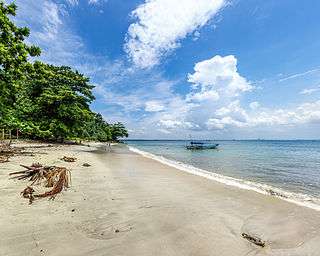
From the mid-1990s, the island was intermittently promoted by local authorities as a tourist destination, primarily for its caves, beaches, and unusual wildlife that is extinct on Java.[23]
Notable attractions include Permisan beach (Pantai Permisan) with its beautiful white and gray sands near the Permisan jail lighthouse, Ranca Babakan on the west coast of the island, White Sands beach (Pantai Pasir Putih), and several caves such as Queen's cave (Goa Ratu). According to the Cilacap Tourism Office, Nusakambangan was opened as a tourist destination following an agreement between the Central Java Governor and Ministry of Justice in 1996. The Cilacap government then invested some Rp 1.7 billion (around $200,000) in preparations for the opening up of the island, most of which was used on the construction of tourist-related infrastructure. A special agency was also established to manage tourism on the island, with the Nusakambangan Prison warden made head of the agency and Cilacap Tourism Office chief as the deputy.[24] No individual tourists are allowed, all of the tourists within a group of minimum 15 persons which is arranged by tourist agency then will be accompanied by security officers until maximum 6 p.m without overnight stay.[25]
One of the main cultural events is Sedekah Laut (sea sacrifice), which is held by the Surakarta Sunanate every Satu Suro (new year) in the Javanese calendar.
Environment
In early 2015, 40 percent of Nusa Kambangan is spoiled by illegal logging and land clearing for plantations. Most of it is occurring in Selokjero, Bantapanjang, Kalijati, Jengkolan, Jongorasu, and Karanglena.[26]
References
- Gelling, Peter (June 3, 2008), "Traveling to Indonesia's Alcatraz to meet the Bali bombers", The New York Times
- McCoy, Terrence (March 4, 2015), Welcome to 'Execution Island,' the surreal death site for Bali 9 drug smugglers, The Washington Post, retrieved 29 April 2015
- "Seeking Asylum". Time. September 1, 2001. Retrieved May 7, 2010.
- "Afghan refugees escape Indonesian Alcatraz". BBC News. September 18, 2001. Retrieved May 7, 2010.
- "Eleven Parmisan villagers still lost". Liputan 6 SCTV.
- "At least 105 dead as Indonesia's tsunami nightmare returns". Antara News Agency. Archived from the original on 2006-09-25. Retrieved 2007-01-23.
- "Nusakambangan: Relief for Prison Island Animals". IFAW Canada.
- "2 Ekor Buaya Nusakambangan Bikin Heboh Emak-Emak di Perahu". liputan6.com (in Indonesian). 24 May 2019.
- "Enhancement of Community Management Land in Nusakambangan under A Collaborative Management Scheme". Small Grants Programme for Operations to Promote Tropical Forests in Southeast Asia, UNDP. Archived from the original on 2007-03-12. Retrieved 2007-01-23.
- Agus Maryono, 'Nusakambangan, a new holiday resort' Archived 2016-01-13 at the Wayback Machine, The Jakarta Post, 1 September 2002.
- "Mencari Makna Kemerdekaan Manusia dari Nusakambangan". Sinar Harapan newspaper.
- "Bali bombers execution date set". BBC News. July 26, 2006. Retrieved May 7, 2010.
- "Bali bombers to be executed in jail". ABC News. Archived from the original on 2008-06-03. Retrieved 2007-01-23.
- "Tommy Suharto moved to prison isle". BBC News. August 15, 2002. Retrieved May 7, 2010.
- "Tommy moved to Indonesian 'Alcatraz'". CNN. Archived from the original on March 8, 2007.
- http://www.bali-islands.co/news/frank-amado-moved-execution-island/. Missing or empty
|title=(help) - "Aceh rebels released as part of peace deal". International Herald Tribune.
- "Tuntas, Isolasi 244 Napi Narkoba". Jawa Pos.
- "Bali bomb burials stoke tensions". BBC News. BBC. 2008. Retrieved 9 November 2008.
- Fedina S. Sundaryani and Agus Maryono, 'Six drug convicts to be executed Sunday: AGO', The Jakarta Post, 16 January 2015.
- Fedina S. Sundaryani, Ina Parlina and Hans Nicholas Jong, Drug convict executions spark international protests', The Jakarta Post, 17 January 2015.
- 'Niniek Karmin, 'Indonesia executes 6 drug convicts, including 5 foreigners', The Jakarta Post, 18 January 2015, 'Brazil, Netherlands recall Indonesian ambassadors after executions', Yahoo! News, 18 January 2015, and Indonesia executes six drug convicts as new president Joko Widodo takes a hard line on drugs', ABC News 18 January 2015.
- "Central Java to promote island resorts", Asia Pulse September 18, 1997. See also Agus Maryono, 'Nusakambangan "a future tourist hub"', The Jakarta Post, 13 March 2012.
- Slamet Susanto and Blontak Poer, 'Nusakambangan, a beautiful tourist resort' Archived 2015-04-02 at the Wayback Machine, The Jakarta Post, 18 December 2004.
- "The hidden splendor of Nusakambangan". September 10, 2012.
- Aris Andrianto (February 1, 2015). "Report: Environment Damage in Nusakambangan Reaches 40%".
| Wikimedia Commons has media related to Nusa Kambangan. |